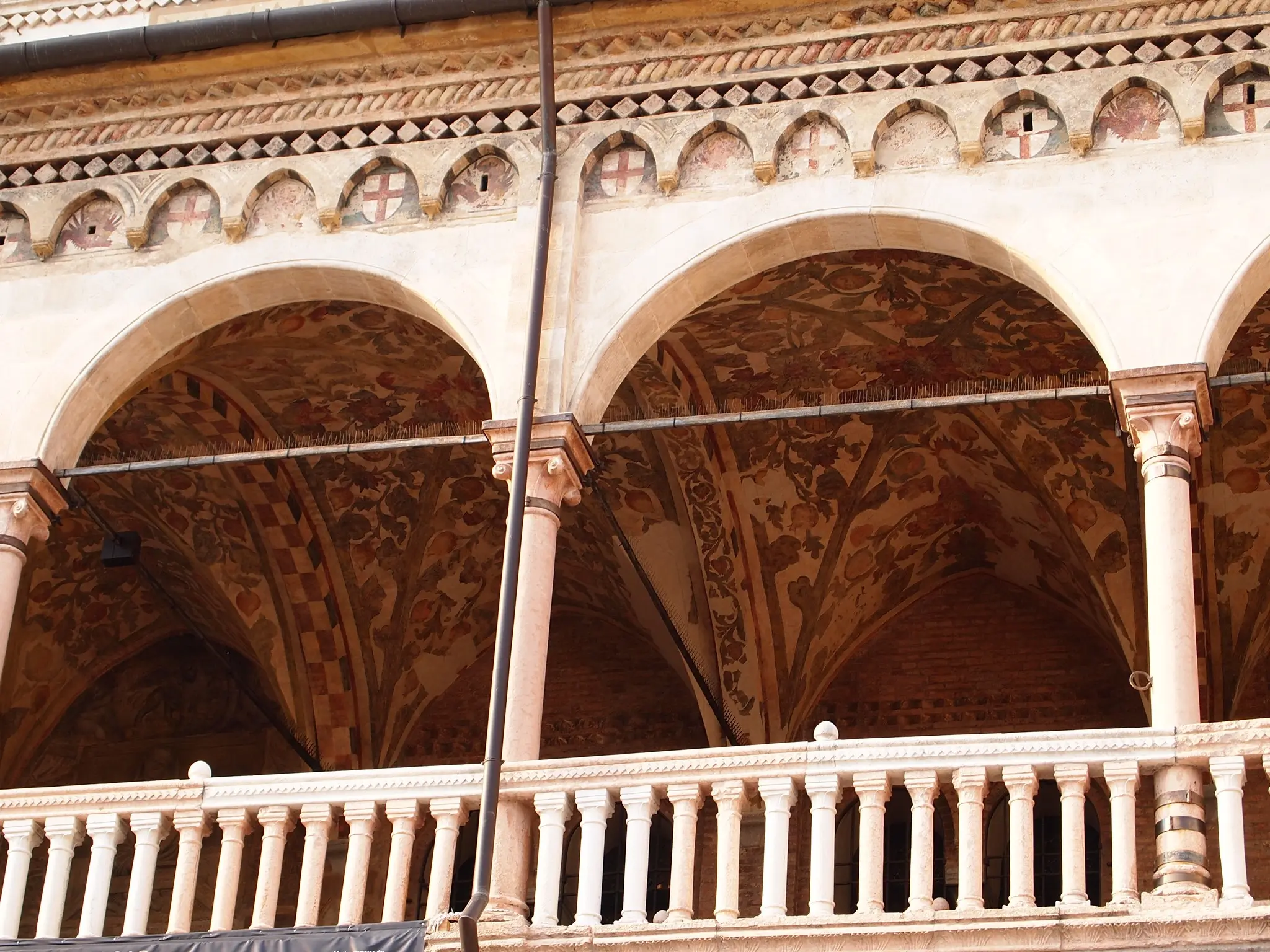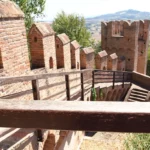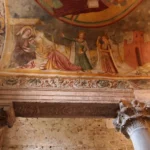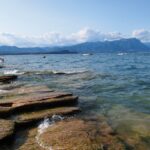Last Updated on 28/09/2023
Usually tourists visit in Padua Prato della Valle Square and the Cathedral of St. Anthony. Of course, Padua was heavily bombed during the Second World War, but still there is something to see, except for the square and the cathedral, and spend at least half a day.
Around Venice and Lido di Jesolo. Map of attractions
Lido di Jesolo beach, map and what to do
Around Venice. Villa Pisani and other Brenta Villas
Euganean Hills. What to visit
Arqua Petrarca
Venice tips. How to get to Venice, Venice museums
Venice San Marco, Doge palace, Basilica of Saint Mark
Venice Grand Canal, around the city, regatta
How to get to Padua (Padova)
From Venice get 25 (Mestre) – 45 minutes by train
Rimini – almost three hours
Bologna – 1 h 10 min – 1 h 40 min.
Padua has a bus and tram on tires, but all the main sights can be seen on foot.
All museums in Padua can be visited free of charge with the Padova Card. You can also use the Padova Card to park for free in the parking lot near Prato della Valle (the parking lot is called Parcheggio Piazza Rabin and is indicated on the second map below).
A little history
According to legend, the city of Patavium was founded by the hero Antenor, who fled with Aeneas from burning Troy, in 1184 BC.
In the 6th c. BC. Patavium became the center of the ancient Venetian civilization. Archaeological finds of that time are kept in the Eremitani Museum.
In the 1st century BC. Padua became part of the Roman Empire. In 601 the city was destroyed to the ground by the Longobards.
The city reaches a new heyday in the 11th century. In 1222 a group of professors and students moved from Bologna, and in 1399 a university was officially founded.
The Basilica del Santo was founded in 1232.
130 towers are being built.
In 1405, Padua was conquered by Venice and was part of the Venetian Republic until 1797.
After the conquest by Napoleon, the city falls under the rule of Austria. From 1848 to 1866, the Padua fought for independence from Austria, and in 1866 Padua became part of the Italian kingdom.
What to see in Padua
Let’s start the journey from the station, which is not quite in the city center (“station” on the map). Those who parked at Prato della Valle start, respectively, in reverse order, from the letter S (second map below).
Padua map

A. Scrovegni Chapel and around it
The first attraction is the ruins of the Roman arena. These are dilapidated 80 arches (60-70 AD), surrounded by a park.
In the 14th century The Scrovegni family built a palace on this site; it was destroyed in the 19th century.
From the Scrovegni Palace, the Annuniciata Chapel (or Scrovegni Chapel, letter A on the map) of 1303 has been preserved, the walls of which are decorated with priceless frescoes by Giotto (1302-1306). Here you can see the cycles “Life of Christ” and “Life of Our Lady”, and one of the walls is dedicated to the Last Judgment.
Visiting the chapel is strictly regulated. They let you into the chapel on time. The first ten minutes show a film about frescoes, the history of their creation and the impact on world culture. The text in Italian is accompanied by subtitles in English and German. Another five minutes are spent on organizational issues: check tickets, sit down, wait for the previous group. After that, you spend another 15 minutes in the chapel itself.
Theoretically, time can be booked on the site, but in practice I could not do it – it didn’t work. As a result, I looked after the time, where there were a lot of empty time windows (and on this day it was almost all the time after lunch), and we came without booking a time and calmly bought tickets at the entrance. However, 1 euro per booking was also taken when buying a ticket in the museum.
In my opinion, the chapel deserves a mandatory visit. Of course, photography is not allowed.
Eremitani Museum
Nearby was the monastery of Eremitani (hermit monks), but it was partially destroyed during the war. The surviving and new premises house the Eremitani Museum, which exhibits the city’s historical and artistic collections. Including tomb steles, finds from tombs (decorative vases) of the 6th c. BC, finds of the era of the Roman Empire, Etruscan finds, including ships of the 7th-8th centuries, works of the Middle Ages, bronze statuettes of the Renaissance and paintings of the 19th century.
There are not so many masterpieces: from significant works two statues of Canova, the Crucifixion of Giotto, works by Jacopo and Giovanni Bellini, two paintings by Giorgione.
A 13th-century church survived from the monastery. It has paintings of the 15th century (including fragments of frescoes by Andrea Mantegna that survived the bombing). The church was also badly damaged and partially restored.
Old town
We continue the path further in a straight line and get into the historical center. There is a university, a municipality, a cathedral here.
The turreted palazzo is called Palazzo Moroni (B). From this palazzo begins the complex of connected palaces, where the municipal authorities are still located.
the palace degli Anziani (Elders, the tower of Anziani is visible on the right on the photo, the letter C) was built from 1285, in the 15th century, fourth floor added
The Podestà Palace was built in the 16th century,
and the Palace of the Council (on the back of the complex) was created in 1283.
It is rather difficult for a tourist to figure out where which palace begins and ends.
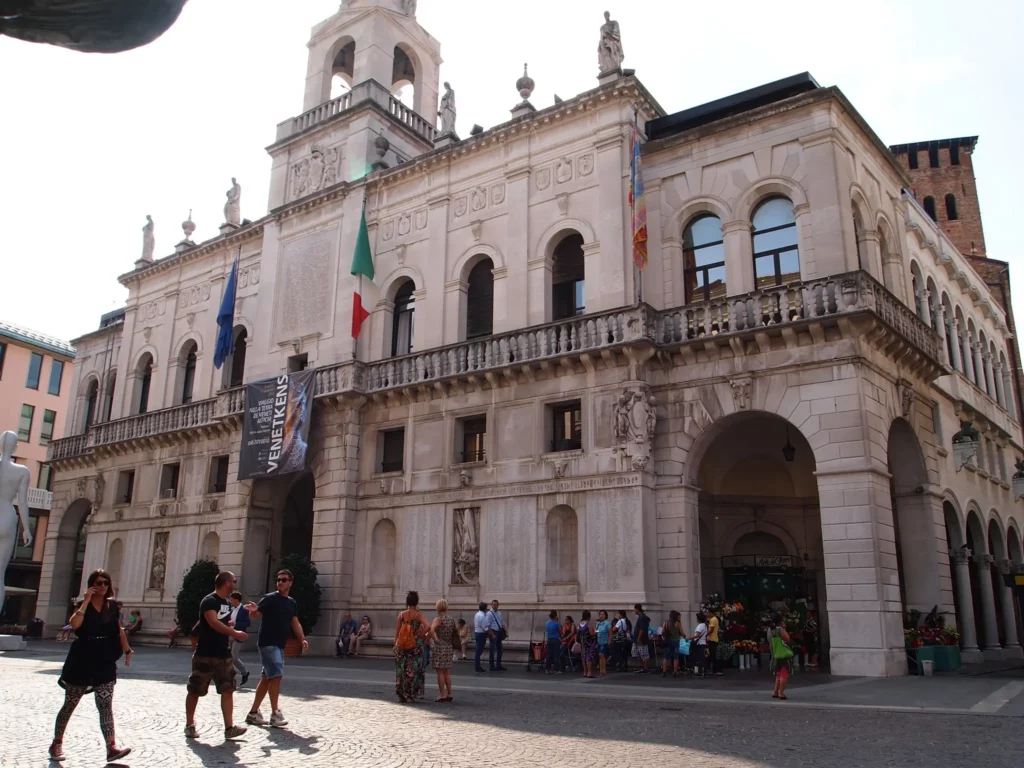
To the right, if you face the palazzo, is the Café Pedrocchi (19th century, D), which attracts attention with its Gothic appearance. Hidden in a narrow street behind a cafe is a tourist office, very valuable for a set of various booklets.
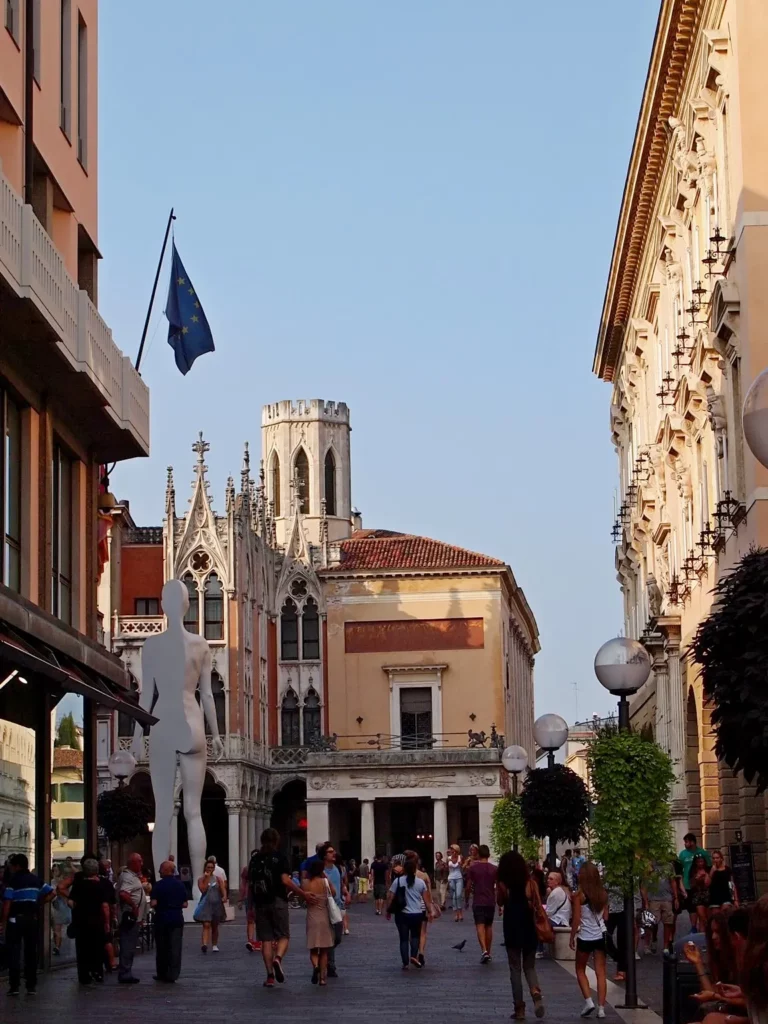
University of Padua – Bo Palace
Opposite the Palazzo del Podesta, the oldest of the university’s buildings is the Bo Palace (Palazzo Bo, letter E).
The building was built on the site of the hotel “Sign of the Bull” (Bo), which the ruler of Padua Francesco Carrara presented to the butcher for the meat that was eaten in 1405 during the siege of the city (according to other sources – even before 1362 and served as the first residence dynasty Da Carrara, and then a hotel). In 1539 the building became the property of the university.
From the 16th century the old courtyard, the pulpit (which is called the pulpit of Galileo Galilei, since he could lecture from it), and the world’s first anatomical theater (1594) have been preserved. A visit to the university is possible with an excursion (several times a week).



Palace of Justice
Now we are going to the huge Palace of Justice (Palazzo della Ragione, or Salon, letter G on the plan).
It was built at the beginning of the 13th century. On the first floor there were trading shops, on the second – offices, on the third – the court. The walls of the Salon, where the Great Council met, are painted with frescoes. After a fire in 1420, a wooden ceiling was built (it has survived to this day), the frescoes were updated twice.
Statues along one of the walls are dedicated to the famous people of Padua, including Titus Livius. The huge Trojan horse standing in the Salon was created in the 15th century. The salon can be seen every day except Mon (entrance from Piazza delle Erbe).
The lower floor is still occupied by retail shops (you can go right through under the building). And from the side of the complex of palaces they arrange an extensive market.


After the fire of 1420, the Great Council was moved to the Loggia Gran Guardia (1496, H) in Signoria Square.
On the same square is the Palace of the Captain (Palazzo del Capitanio) of the 16th century, the clock tower and the medieval church of San Clemente.
The construction of the Loggia was completed by the Pisan architect Falconetto, who began the Renaissance in the architecture of Padua. He also owns the bronze doors of the Captain’s palace.
Clock tower
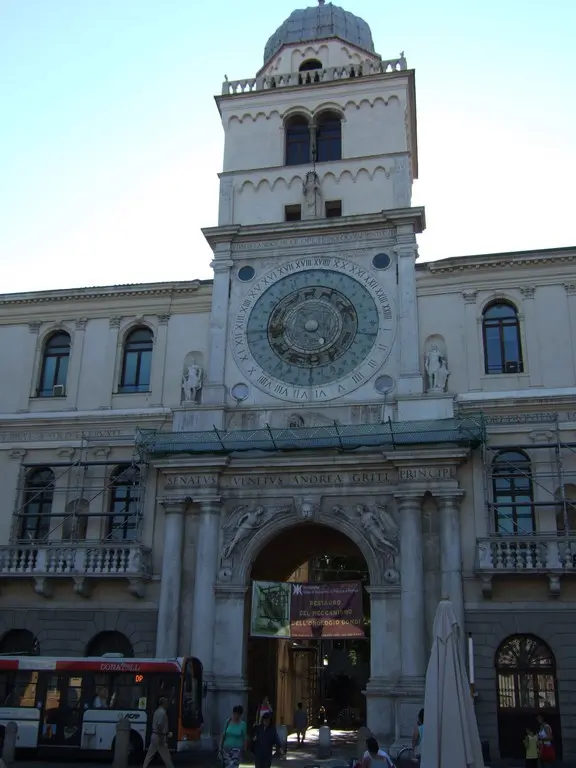
Cathedral of Padua
From here we will make a short detour to the Church of San Nicolo (I) and we will go to the Duomo of Padua, which is not the Basilica of St. Anthony, you might think.
The Cathedral of the Assumption of the Virgin (Santa Maria Assunta, K) was built in the 16th century according to the projects of various architects, which is noticeable in its appearance. The murals inside date back to the 18th century.
More interesting is the nearby baptistery (built in the 12th century). Inside the walls are frescoed by Giusto.
Also next to the cathedral is the new Diocesano Museum. It is located in the episcopal palace and presents works of ecclesiastical art (painting, sculpture, manuscripts) over the past thousand years.
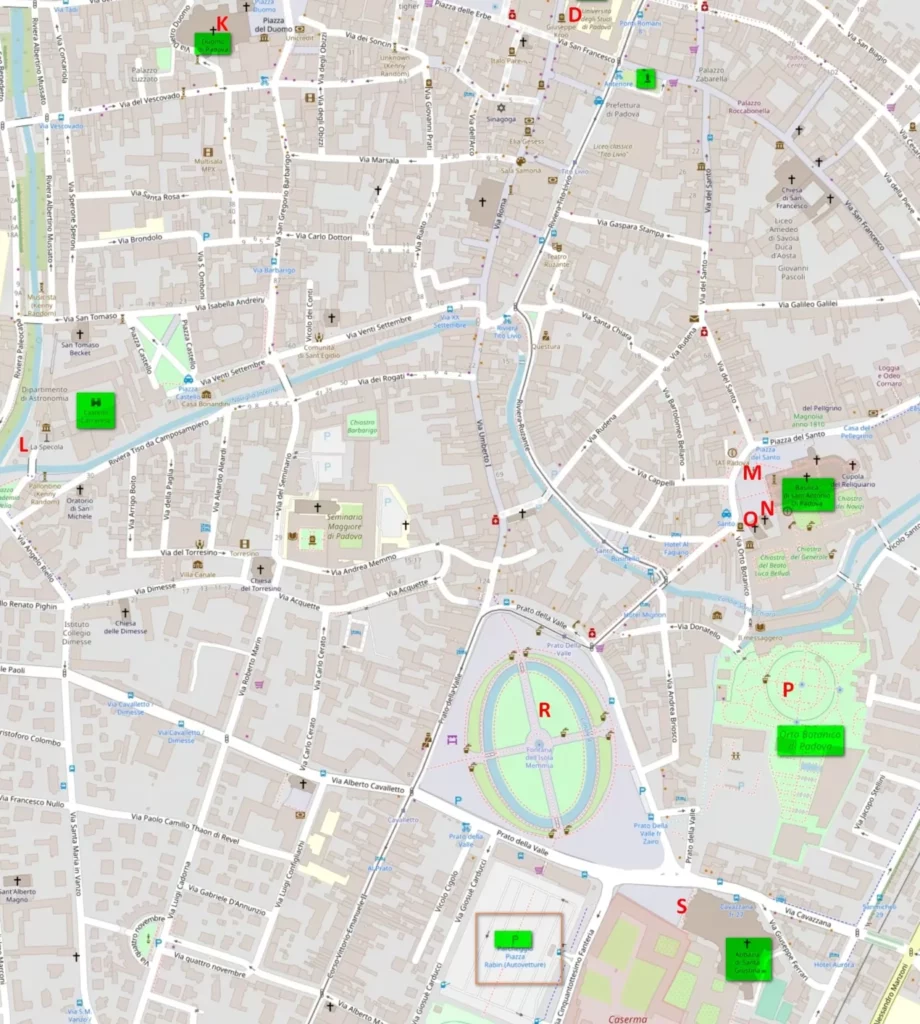
From the cathedral you can go to Piazza Castello with a medieval castle (L, only the observatory tower is available for visiting) or go straight to the Basilica of St. Anthony (M).

The more important church in Padua is not a cathedral, but the Basilica of St. Anthony.
Basilica of St. Anthony and around it
The Franciscan Anthony, who had preached for two years in Padua, died in 1231 near the city. In 1232 he was canonized as a saint. Basilica of St. Anthony of Padua was built from 1256 to 1263 (central nave), but was remodeled several times over the centuries.
Despite this, the basilica seems very harmonious. The domes are reminiscent of oriental architecture – Byzantine temples, and the bell towers of the 15th century – minarets.


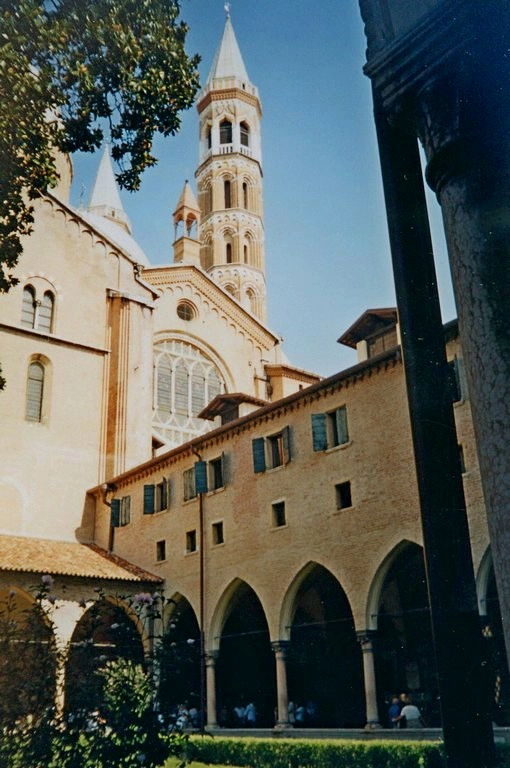
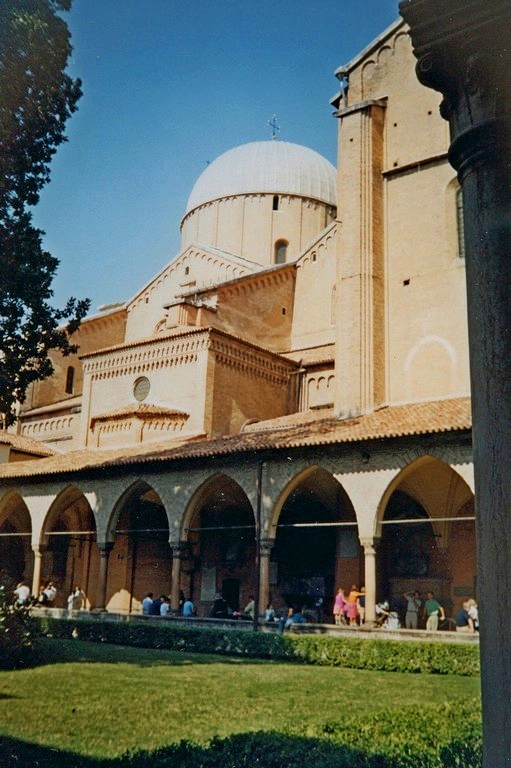
Paintings inside were created in different periods, partly damaged by fires. Significant works include the bronze Crucifixion by Donatello (mid-15th century) over the altar and bronze reliefs by Donatello and his students depicting the miracles of St. Anthony.
Some chapels of the cathedral was built at the expense of various countries for their students studying at the university. The Chapel of the Relics houses the reliquary of St. Anthony and various gold and silver items. Tomb of St. Anthony is installed in the chapel of St. Anthony, votive offerings are hung along the steps leading to the tomb. Prayers crowd around the tomb even on a normal week day.
In the monastery courtyards there is a museum of St. Anthony, where, among other things, a fresco with Saints Anthony and Bernardo by Andrea Mantegna is kept (its copy is installed above the main portal of the cathedral).

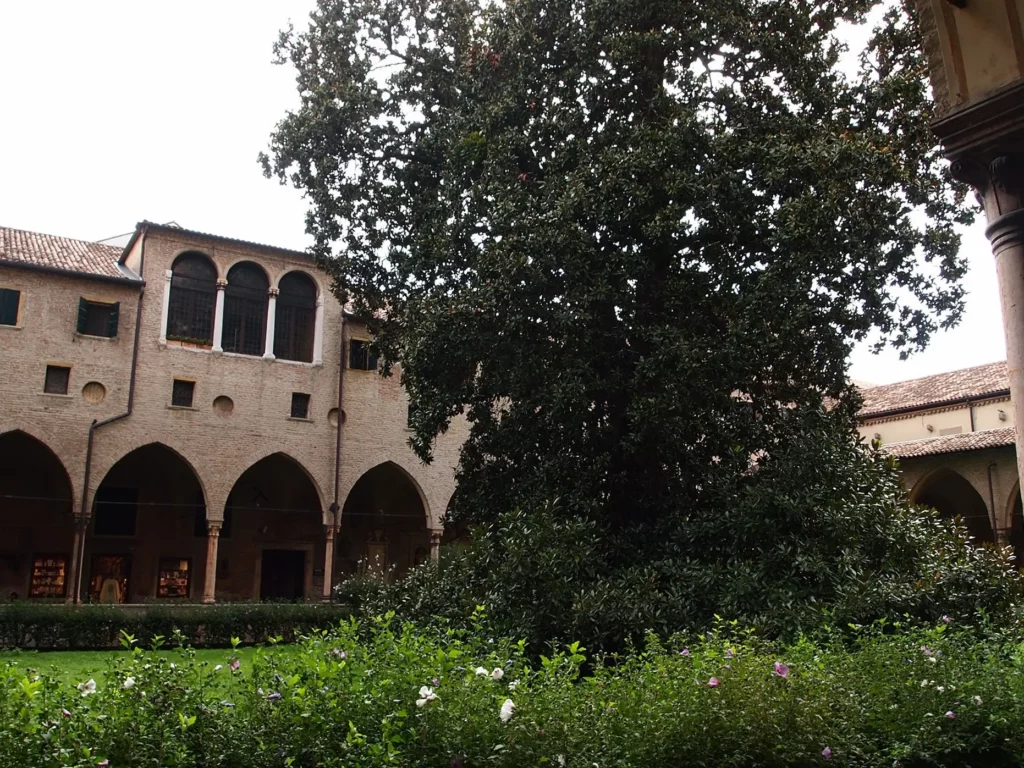
On Piazza del Santo, there is an equestrian statue of the condottiere of the Venetian Republic, Erasmo da Narni, nicknamed Gattamelata, by Donatello.
To the left of the basilica, if you stand with your back to the entrance, there are two buildings. One is the chapel of San Giorgio (left of the two, N), the second is the Scuola del Santo (right, O). In the photo, respectively, the second is on the edge, the first is closer to the basilica.
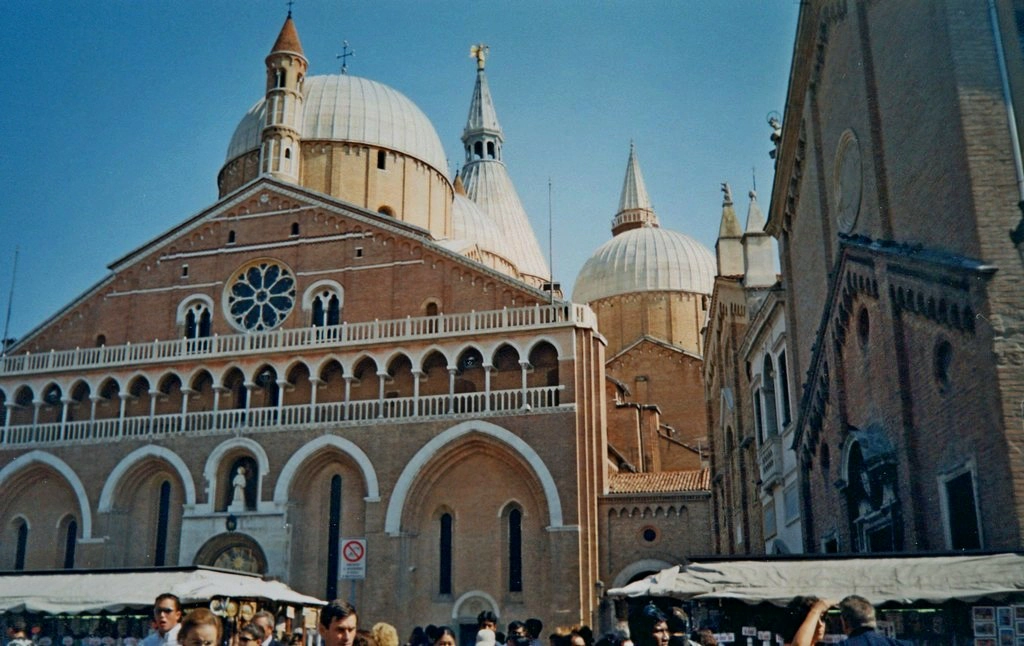
The chapel was built in the 14th century.
In Scuola del Santo, members of the brotherhood of St. Anthony gathered. They were the laity who lived according to the teachings of St. Francis. The building was built in the 15th century. Of greatest interest is the chapter hall on the second floor. Its walls are painted by famous Italian artists. Three frescoes were created by Titian: “St. Anthony gives the baby the gift of speech”, “St. Anthony heals a woman wounded by a jealous husband”, “St. Anthony heals a severed leg.”
Thus, if you wanted to see Titian, do not mix up the entrances.
Botanical Garden of Padua
From the cathedral we turn into the first lane to the left and soon we find ourselves at the botanical garden.
Botanical Garden of Padua (P) – one of the first in Europe, was laid out in 1545 and is on the UNESCO list (as well as the Scrovegni Chapel). The central part has survived to this day, it is fenced with a wall, behind which are medicinal and rare plants. The active wanderings of the Venetians allowed the garden to constantly replenish the collection of exotic plants.
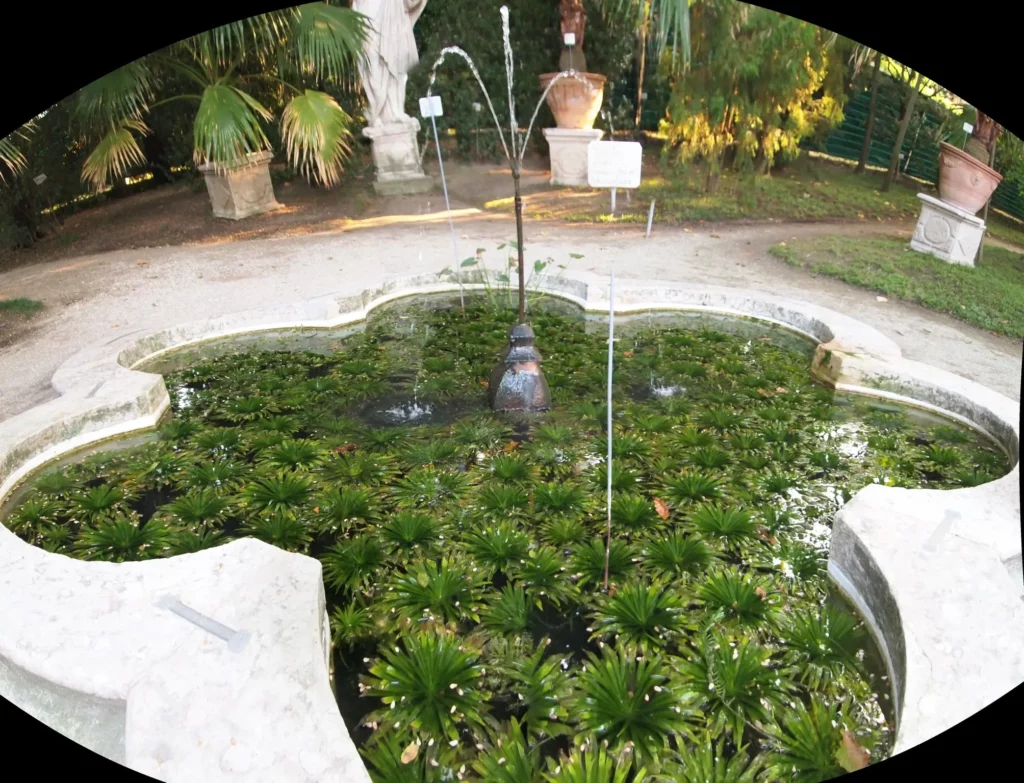

Prato della Valle
Finally, the last two points of the compulsory program: Prato della Valle (R) and Santa Giustina Basilica.
Once there was a Roman theater Zairo, then there were large gatherings of citizens, fairs and competitions. But the abbey of St. Giustina (S), who owned the territory, did not have the means to drain it, so by the 18th century there was a swamp. In the 18th century the territory passed into city ownership, the final drainage was carried out, a canal was created and a pipe system was laid.

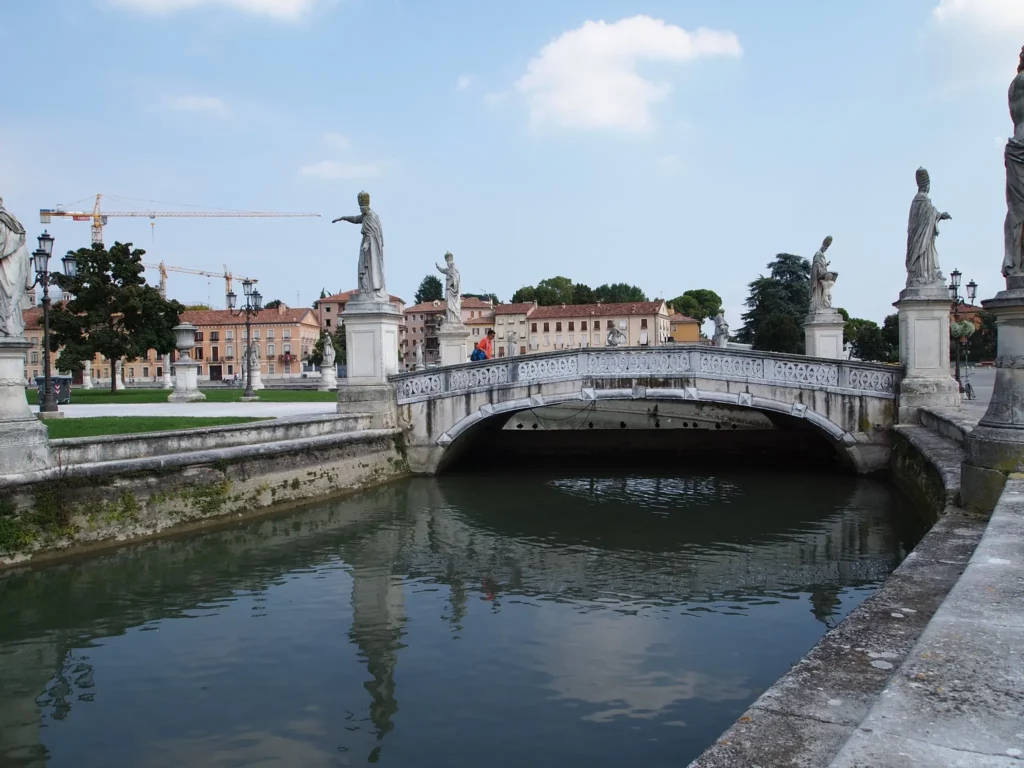
Near the square is the Basilica of Santa Giustina. It was erected on the site where the martyr of the reign of Maximilian and later other Christians were buried. The church that we see now was built in the first half of the 16th century, but the facade was never completed.

Follow me
Do you have any more questions? Use comments ⇓ or private communication form ⇨
From Santa Giustina we turn back to the station. If there is no strength left, it is easy to return from the square to the station by public transport.
What to visit in Padua
A walk through Padua, along with the Scrovegni Chapel, Palazzo Ragione and the Botanical Garden, will take you at least half a day. If you want to visit other museums in the city, plan more time.
Among the places to visit already mentioned:
Scrovegni Chapel and Eremitani Museum
Palazzo Ragione
anatomical theater
Museum of Diocesano
Botanical Garden
Also in the range:
Museum of Medicine with a new multimedia exhibition
Cappella della Reggia Carrarese (on the other side of the Palace of the Captains)
Around Padua:
Villas of Brenta (mainly Villa Pisani),
Arcua Petrarca,
what to see in the Euganean Hills
Attractions around Venice – map and links.
Do you enjoy the site without cookies? This means that I work for you at my own expense.
Perhaps you would like to support my work here.
Or change your cookie settings here. I don’t use personalized ads

